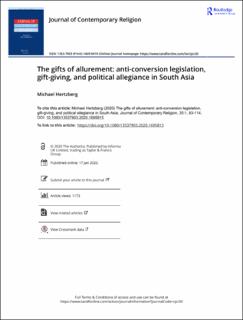| dc.contributor.author | Hertzberg, Michael Ivan | |
| dc.date.accessioned | 2021-06-22T07:14:51Z | |
| dc.date.available | 2021-06-22T07:14:51Z | |
| dc.date.created | 2020-03-10T13:07:44Z | |
| dc.date.issued | 2020 | |
| dc.Published | Journal of Contemporary Religion. 2020, 35 (1), 93-114. | |
| dc.identifier.issn | 1353-7903 | |
| dc.identifier.uri | https://hdl.handle.net/11250/2760531 | |
| dc.description.abstract | The last decade has seen an escalation of various acts of anti-conversion legislation in Nepal, Sri Lanka, and in different states of India. Several scholars comment that the upsurge of anti-conversion legislation can be linked to the ascension of religious nationalism in India and Sri Lanka, yet recent trends indicate that such laws are also proposed by moderate political forces. What is notable about this anti-conversion legislation is that it criminalizes ‘improper’ conversions along the lines of force, fraud, and allurement/inducement. While Article 18(2) of the International Covenant of Civil and Political Rights (ICCPR) protects against coercion, and thus forcible conversions, and while the concepts of force and fraud are already covered by the penal codes of the respective countries, the remaining element of controversy of anti-conversion legislation is that of allurement and/or inducement. ‘Allurement’ is defined as the offer of any temptation for the purpose of converting a person professing one religion to another religion, in the form of: “(i) any gift or gratification whether in cash or kind, (ii) a grant of any material benefit, whether monetary or otherwise, (iii) the grant of employment or grant of promotion in employment” (Owens 2006–2007, 337). Yet, despite critical remarks from the UN Special Rapporteur on the Freedom of Religion or Belief, Asma Jahangir, that these anti-conversion proposals are vague in their formulations and may lead to religious persecution, the legislative attempts are persistent in their demand to criminalize the allegedly religious gifts of allurement. This article argues that the rationale behind anti-conversion legislation stems from a threefold objective: (1) the dislike of gifts from the religious Other in particular and proselytization in general, (2) legislation as a regulating mechanism of majority religious bodies vis-à-vis religious minorities, (3) anti-conversion laws demanding the complicity of the state in relation to the majority religions, accentuating state patronage as a tacit form of state religion bill. | en_US |
| dc.language.iso | eng | en_US |
| dc.publisher | Taylor & Francis | en_US |
| dc.rights | Attribution-NonCommercial-NoDerivatives 4.0 Internasjonal | * |
| dc.rights.uri | http://creativecommons.org/licenses/by-nc-nd/4.0/deed.no | * |
| dc.subject | Religionsfrihet | en_US |
| dc.subject | Religious Freedom | en_US |
| dc.title | The gifts of allurement: anti-conversion legislation, gift-giving, and political allegiance in South Asia | en_US |
| dc.type | Journal article | en_US |
| dc.type | Peer reviewed | en_US |
| dc.description.version | publishedVersion | en_US |
| dc.rights.holder | Copyright 2020 The Author | en_US |
| cristin.ispublished | true | |
| cristin.fulltext | postprint | |
| cristin.qualitycode | 2 | |
| dc.identifier.doi | 10.1080/13537903.2020.1695815 | |
| dc.identifier.cristin | 1800868 | |
| dc.source.journal | Journal of Contemporary Religion | en_US |
| dc.source.40 | 35 | |
| dc.source.14 | 1 | |
| dc.source.pagenumber | 93-114 | en_US |
| dc.subject.nsi | VDP::Religionsvitenskap, religionshistorie: 153 | en_US |
| dc.subject.nsi | VDP::Religious studies, history of religion: 153 | en_US |
| dc.identifier.citation | Journal of Contemporary Religion. 2020, 35(1), 93-114 | en_US |
| dc.source.volume | 35 | en_US |
| dc.source.issue | 1 | en_US |

